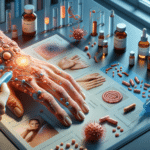Understanding Basal Cell Carcinoma: Essential Facts
Basal cell carcinoma (BCC) is recognized as the most prevalent form of skin cancer. It originates in the basal cells, which are found in the epidermis, the outermost layer of the skin. While BCC is generally not life-threatening, it can cause significant disfigurement if not treated promptly. The primary cause of BCC is prolonged exposure to ultraviolet (UV) radiation from the sun or tanning beds. This type of skin cancer is more common in individuals with fair skin, although it can affect anyone.
Key characteristics of BCC include its tendency to develop on sun-exposed areas of the body, such as the face, ears, neck, scalp, shoulders, and back. It often appears as a change in the skin, such as a growth or sore that does not heal. While BCC rarely spreads to other parts of the body, it can invade surrounding tissues, making early detection and treatment crucial.
Understanding the risk factors associated with BCC can aid in prevention and early detection. These include:
- Excessive sun exposure without protection
- History of sunburns, especially in childhood
- Use of tanning beds
- Personal or family history of skin cancer
- Fair skin, light hair, and eye color
Being informed about these facts can empower individuals to take proactive steps in safeguarding their skin health.
The Spread of Basal Cell Carcinoma: How It Occurs
Unlike other forms of skin cancer, basal cell carcinoma is known for its slow-growing nature. It typically remains localized, meaning it does not often spread to distant parts of the body. However, BCC can grow deep into the skin and affect surrounding tissues if left untreated, leading to potential complications.
The spread of BCC is primarily localized, affecting the nearby skin and tissues. This local invasion can result in damage to nerves, muscles, and bones, depending on the tumor’s location. Although rare, more aggressive forms of BCC can metastasize, spreading to other organs, which underscores the importance of early intervention.
Several factors influence the behavior of BCC, including:
- The size and location of the tumor
- The depth of penetration into the skin
- The histological subtype of the carcinoma
Understanding these factors can help in assessing the potential risk and determining the most appropriate treatment plan. Regular skin examinations and prompt medical attention to suspicious changes are vital in preventing the spread of BCC.
Early Warning Signs of Basal Cell Carcinoma
Early detection of basal cell carcinoma significantly increases the chances of successful treatment and minimizes the risk of extensive damage. Recognizing the early warning signs is crucial for timely intervention. BCC often presents as subtle changes in the skin, which may be easily overlooked if one is not vigilant.
Common early signs of BCC include:
- A pearly or waxy bump on the skin, often with visible blood vessels
- A flat, flesh-colored or brown scar-like lesion
- A bleeding or scabbing sore that heals and then returns
- A red, irritated patch of skin that may itch or hurt
These manifestations can vary in appearance, making it essential to pay attention to any persistent changes in the skin. Regular self-examinations and dermatological check-ups can aid in catching these signs early. If any suspicious lesions are observed, consulting a healthcare professional promptly is advisable.
By staying informed and attentive to these early indicators, individuals can take proactive measures in managing their skin health and potentially prevent the progression of basal cell carcinoma.
Preventative Measures and Treatment Options
Prevention plays a critical role in reducing the risk of basal cell carcinoma. By adopting sun-safe behaviors, individuals can significantly lower their chances of developing this common skin cancer. Key preventative measures include:
- Wearing broad-spectrum sunscreen with a high SPF
- Seeking shade during peak sun hours
- Wearing protective clothing, hats, and sunglasses
- Avoiding tanning beds
In addition to prevention, understanding the available treatment options for BCC is essential. Treatment typically depends on the size, depth, and location of the cancer, as well as the patient’s overall health. Common treatments include:
- Surgical excision to remove the tumor
- Cryotherapy to freeze and destroy cancer cells
- Topical medications for superficial BCCs
- Radiation therapy for inoperable cases
Consulting with a dermatologist can help determine the most suitable treatment approach based on individual circumstances. Early intervention not only improves outcomes but also minimizes the potential for recurrence.
Conclusion: Staying Vigilant for Healthy Skin
Basal cell carcinoma, while common, is a skin cancer that should not be underestimated. Understanding its characteristics, early warning signs, and methods of spread can empower individuals to take proactive steps in protecting their skin health. By recognizing the importance of prevention and early detection, individuals can significantly reduce their risk of complications associated with BCC.
Regular skin examinations, both self-conducted and by healthcare professionals, are vital in catching any suspicious changes early. By embracing sun-safe practices and staying informed about skin health, individuals can contribute to their overall well-being and enjoy the outdoors with confidence.
Ultimately, awareness and vigilance are key in ensuring that basal cell carcinoma is detected and treated promptly, preserving not only the health of the skin but also the quality of life.


